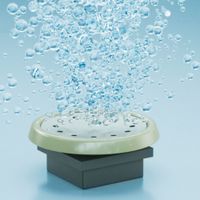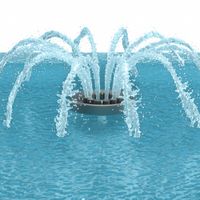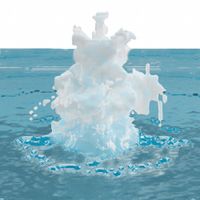Call +(254) 703 030 000 / 751 483 999 / 721 704 777
- Home
- Pumps
- Pond Aeration Fountain Waterfall Pumps
- Pond Wastewater Aerators
Pond & Wastewater Aerators
Pond and wastewater aerators turn over water with air bubbles to improve water quality. Aeration improves the water quality within a pond by reducing muck, lowering the number of mosquitos, and preventing algae bloom which can cause fish kill. Diffused aerators create and continuously release bubble .....Read More
Frequently Asked Questions
What is the purpose of pond aeration?
Pond aeration serves several critical purposes that contribute to the health and balance of aquatic ecosystems. Primarily, it increases the oxygen levels in the water, which is essential for the survival of fish, beneficial bacteria, and other aquatic organisms. Oxygen is vital for the decomposition of organic matter by aerobic bacteria, which helps in reducing sludge and preventing the buildup of harmful gases like ammonia and hydrogen sulfide.
Aeration also promotes the circulation of water, which helps in distributing oxygen and nutrients evenly throughout the pond. This circulation prevents stratification, a condition where water layers of different temperatures and oxygen levels form, leading to poor water quality and potential fish kills. By mixing the water, aeration ensures a uniform temperature and oxygen distribution, creating a more stable environment for aquatic life.
Moreover, aeration helps in controlling algae growth. Algae thrive in stagnant, nutrient-rich water with low oxygen levels. By increasing oxygen and improving water movement, aeration can limit the conditions that favor excessive algae blooms, thus maintaining clearer water and reducing the risk of toxic algae outbreaks.
Additionally, aeration can enhance the aesthetic appeal of a pond by reducing foul odors associated with anaerobic decomposition and by maintaining clearer water. It also supports the breakdown of organic waste, reducing the need for chemical treatments and promoting a more natural and sustainable pond environment.
In summary, pond aeration is crucial for maintaining a healthy aquatic ecosystem by increasing oxygen levels, promoting water circulation, controlling algae growth, and enhancing overall water quality.
How does a pond aerator improve water quality?
A pond aerator improves water quality by enhancing oxygen levels, promoting beneficial bacteria growth, reducing harmful gases, and improving water circulation. By introducing oxygen into the water, aerators facilitate the breakdown of organic matter by aerobic bacteria, which are more efficient than anaerobic bacteria. This process reduces the accumulation of sludge and organic debris at the pond's bottom, minimizing foul odors and preventing the release of toxic gases like hydrogen sulfide and methane.
Increased oxygen levels also support the health and growth of aquatic life, including fish and beneficial microorganisms. Fish require oxygen for respiration, and higher oxygen levels reduce stress and improve their overall health. Additionally, beneficial microorganisms thrive in oxygen-rich environments, helping to control algae growth by outcompeting algae for nutrients.
Aerators also enhance water circulation, preventing stratification, where water layers separate based on temperature and oxygen levels. Stratification can lead to oxygen depletion in deeper layers, creating dead zones where aquatic life cannot survive. By mixing the water, aerators ensure a uniform distribution of oxygen and nutrients throughout the pond, supporting a balanced ecosystem.
Furthermore, improved circulation helps distribute nutrients and prevent the buildup of sediments and pollutants, reducing the risk of algal blooms. Algal blooms can deplete oxygen levels and release toxins, harming aquatic life and degrading water quality.
Overall, pond aerators play a crucial role in maintaining a healthy aquatic environment by improving oxygenation, supporting beneficial bacteria, preventing stratification, and reducing the risk of harmful algal blooms, ultimately leading to clearer, cleaner, and healthier water.
What are the different types of pond aerators?
There are several types of pond aerators, each designed to improve water quality and oxygen levels in different ways:
1. **Surface Aerators**: These aerators float on the water's surface and agitate the water to increase oxygen transfer. They are effective for shallow ponds and are often used in aquaculture and wastewater treatment.
2. **Fountain Aerators**: Combining aesthetics with functionality, fountain aerators spray water into the air, creating a visually appealing display while increasing oxygenation. They are suitable for decorative ponds and small water bodies.
3. **Diffused Aerators**: These systems use an air pump to push air through tubing to diffusers placed at the bottom of the pond. The diffusers release fine bubbles that rise to the surface, promoting oxygenation and circulation. They are ideal for deeper ponds and are energy-efficient.
4. **Windmill Aerators**: Powered by wind, these aerators use mechanical energy to pump air into the pond. They are eco-friendly and cost-effective, suitable for remote locations without electricity.
5. **Solar Aerators**: Utilizing solar panels to power the aeration system, these are environmentally friendly and ideal for sunny locations. They are often used in small to medium-sized ponds.
6. **Electric Aerators**: These are powered by electricity and can be either surface or diffused systems. They are reliable and effective for continuous operation, suitable for various pond sizes.
7. **Paddle Wheel Aerators**: Commonly used in aquaculture, these aerators have rotating paddles that agitate the water, increasing oxygen levels. They are effective for large, shallow ponds.
Each type of aerator has its advantages and is chosen based on the specific needs of the pond, such as size, depth, and location.
How do diffused aerators work?
Diffused aerators work by introducing air into a liquid, typically water, through a system of diffusers that break the air into small bubbles. This process increases the oxygen transfer efficiency and promotes the mixing of the liquid. The system generally consists of a blower or compressor that supplies air, piping to distribute the air, and diffusers that release the air into the liquid.
The diffusers are usually located at the bottom of a tank or basin and can be made of various materials such as ceramic, plastic, or rubber. They come in different forms, including fine bubble diffusers and coarse bubble diffusers. Fine bubble diffusers produce smaller bubbles, which have a larger surface area and rise slowly, allowing more time for oxygen to dissolve into the liquid. Coarse bubble diffusers produce larger bubbles that rise quickly, providing more mixing but less oxygen transfer efficiency.
As the bubbles rise, they create a vertical circulation pattern that helps mix the liquid, ensuring that oxygen is evenly distributed throughout the tank. This is particularly important in wastewater treatment processes, where maintaining aerobic conditions is crucial for the breakdown of organic matter by microorganisms.
Diffused aeration systems are preferred for their energy efficiency and ability to provide uniform oxygen distribution. They are commonly used in municipal and industrial wastewater treatment plants, aquaculture, and other applications where maintaining dissolved oxygen levels is essential.
What is the difference between surface aerators and fountain aerators?
Surface aerators and fountain aerators both serve the purpose of increasing oxygen levels in water bodies, but they differ in design, function, and application.
Surface aerators are designed to agitate the water surface, promoting oxygen transfer from the air into the water. They typically consist of a motor-driven impeller or propeller that churns the water, creating turbulence and increasing the surface area for gas exchange. Surface aerators are highly effective in oxygenating large volumes of water and are commonly used in wastewater treatment plants, fish farms, and large ponds. They are efficient in mixing and circulating water, which helps in reducing stratification and promoting uniform oxygen distribution.
Fountain aerators, on the other hand, combine aesthetic appeal with functional aeration. They use a pump to draw water from the pond or lake and spray it into the air in decorative patterns. As the water droplets fall back into the body of water, they capture oxygen from the air. While fountain aerators do provide some level of aeration, their primary purpose is often ornamental, enhancing the visual appeal of a water feature. They are typically used in smaller ponds, decorative lakes, and residential water gardens.
In summary, the main differences lie in their primary functions and applications: surface aerators focus on efficient oxygenation and water circulation, making them suitable for larger and more industrial applications, while fountain aerators offer a balance of aeration and aesthetic enhancement, ideal for smaller, decorative settings.
How often should a pond aerator be used?
A pond aerator should ideally be used continuously, 24 hours a day, to maintain optimal oxygen levels and ensure a healthy aquatic environment. Continuous aeration helps prevent stratification, where different water layers form based on temperature, leading to oxygen depletion in deeper areas. This constant operation is particularly crucial during warmer months when water temperatures rise, and the risk of oxygen depletion increases due to heightened biological activity and decomposition rates.
However, in cooler climates or during colder months, aerators can be operated less frequently, such as during the daytime when photosynthesis from aquatic plants naturally increases oxygen levels. In these conditions, running the aerator for 8-12 hours a day may suffice, particularly if the pond is not heavily stocked with fish or organic matter.
For ponds in regions with freezing temperatures, aerators should be used to keep a portion of the pond surface ice-free, ensuring gas exchange and preventing toxic gas buildup. In such cases, running the aerator continuously or at least during the coldest parts of the day is advisable.
The specific frequency and duration of aerator use can also depend on factors such as pond size, depth, fish population, and the presence of aquatic plants. Regular monitoring of water quality parameters like dissolved oxygen levels can help determine the appropriate aeration schedule. Adjustments should be made based on seasonal changes, fish behavior, and any signs of poor water quality, such as foul odors or fish gasping at the surface.
Ultimately, the goal is to maintain a balanced ecosystem, and consistent aeration is a key component in achieving this.
What are the benefits of using a pond aerator?
A pond aerator offers several benefits that enhance the health and aesthetics of a pond ecosystem. Firstly, it increases oxygen levels in the water, which is crucial for the survival and growth of fish and beneficial microorganisms. Higher oxygen levels help in the decomposition of organic matter, reducing sludge and preventing the buildup of harmful gases like ammonia and hydrogen sulfide.
Secondly, aeration promotes the circulation of water, which helps in distributing nutrients and oxygen evenly throughout the pond. This circulation prevents stratification, where water layers of different temperatures and oxygen levels form, leading to unhealthy conditions for aquatic life.
Thirdly, aeration helps control algae growth. By increasing oxygen and improving water movement, aerators can limit the conditions that favor excessive algae blooms, which can deplete oxygen and block sunlight, harming aquatic plants and animals.
Additionally, aeration can improve water clarity and quality. By facilitating the breakdown of organic waste and reducing the accumulation of debris, aerators help maintain clear water, enhancing the pond's visual appeal.
Moreover, aeration can prevent the formation of ice in winter, providing a refuge for fish and other aquatic organisms by maintaining open water areas. This is particularly beneficial in colder climates where ice cover can lead to oxygen depletion.
Finally, a well-aerated pond supports a balanced ecosystem, promoting biodiversity by creating a hospitable environment for a variety of aquatic species. This balance can lead to a more resilient ecosystem that can better withstand environmental stresses.
In summary, pond aerators are essential tools for maintaining a healthy, balanced, and visually appealing pond environment, benefiting both the aquatic life and the overall ecosystem.


